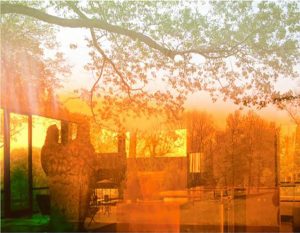
![]() A consideration of the built environment often poses questions of opposition: natural vs. human-made, wild vs. controlled, nature vs. culture. Buildings are often seen as interventions in the landscape or interruptions in the natural world. As truly natural settings are increasingly a thing of the past, we admire architectural icons that acknowledge the interplay between the natural and the built. Philip Johnson’s Glass House, a transparent cube in a wooded setting completed in 1949, is such an icon.
A consideration of the built environment often poses questions of opposition: natural vs. human-made, wild vs. controlled, nature vs. culture. Buildings are often seen as interventions in the landscape or interruptions in the natural world. As truly natural settings are increasingly a thing of the past, we admire architectural icons that acknowledge the interplay between the natural and the built. Philip Johnson’s Glass House, a transparent cube in a wooded setting completed in 1949, is such an icon.
James Welling is a conceptual photographer whose work explores perception, abstraction, memory, and multiple definitions of photography. His series of photographs of the Glass House, made between 2006 and 2009, do all of these at once. In these photographs, Welling melds architecture, nature, and abstraction to produce dreamy meditations on the intersection between the natural and the built environment.
Using a digital camera on a tripod, Welling photographed through a variety of colored plastic and glass filters held in front of the lens to create veils of glowing color. Juxtaposing the glass cube of the house with the natural setting around it, Welling breaks the boundaries between the usually separate categories of landscape and architecture. As he put it, “When I realized I could make the grass red or make sun flares, splatters, and different types of visual activity in front of this supposedly transparent house, or box, the project became a laboratory for ideas about transparency, reflectivity, and color.”[footnote]”James Welling,” Artforum January 26, 2010. https://www.artforum.com/words/id=24743. Accessed March 13, 2017.[/footnote]